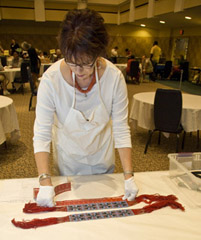January 11, 2012
Marla Day looks at textiles in Smithsonian African-American project

When the Smithsonian Institution launched "Save Our African-American Treasures," the staff called Marla Day, curator of the Historic Costume and Textile Collection at K-State’s College of Human Ecology. They needed her expertise to help appraise and explain potential textile treasures brought in during a series of "Antiques Roadshow"-type events.
Day traveled to four cities: Detroit, Dallas, Topeka and Houston. She examined quilts, peeked in pockets, checked out articles of clothing and cradled rag dolls, looking at hundreds of textile objects. "We didn’t put values on the objects," Day said. "We tried to help people understand what the object was and how to preserve it." Often she packed the item in archival, acid-proof paper before handing it back.
"Most wanted to know the history of the object," Day said.
The mission of the program is to raise awareness about how important family heirlooms are in telling the story of African-American history and to provide information about how to care for them, according to the Smithsonian. While Day and several others examined textiles brought to the sites, other experts looked at objects, photographs, papers and books.
"I love interacting with the people, talking with them about the treasures they brought in," Day said. "Sometimes they were clueless about they had. When I could give them a piece of information they didn’t have about the treasure, they saw the object in a new, fresh perspective. I could help them learn more about their families."
In Houston in October, the textiles group saw lots of quilts and crocheted pieces, a few dolls and some clothing. One person brought in a Black Sox uniform. The Black Sox was a professional team from Baltimore that won the American Negro League championship in 1929.
Several of the quilts had new tops and backs sewn on older worn-out quilts. This recycling was common in the 19th century, Day said.
One woman brought in a quilt obviously made from scraps of fabric that were well worn. Some of the scraps were patched.
"She told me that she came from a large, poor family and her mother wasted nothing, not even fabric with holes worn in it," Day said. "The holes were carefully matched with patches so they were hardly noticeable and the edges were neatly turned under with her tiny hand stitches.
"I showed her how the quilt was actually two quilts, the second layer was probably infant and baby blankets. It was lovely to help her discover more of her family stories, to piece together memories of living with mother and how she made do."
In Houston Day worked with Renée Anderson, museum specialist, Smithsonian National Museum of African-American History and Culture, and Mary Ballard, senior textiles conservator, Museum Conservation Institute, Smithsonian Institution.
"I loved working with other professionals in the museum field," Day said. "It was a great network of people and I was representing K-State to that community."
It was an honor to work with the people at the Smithsonian Conservation Center and the National Museum of African-American History and Culture, she said about her one-on-one consultations.
